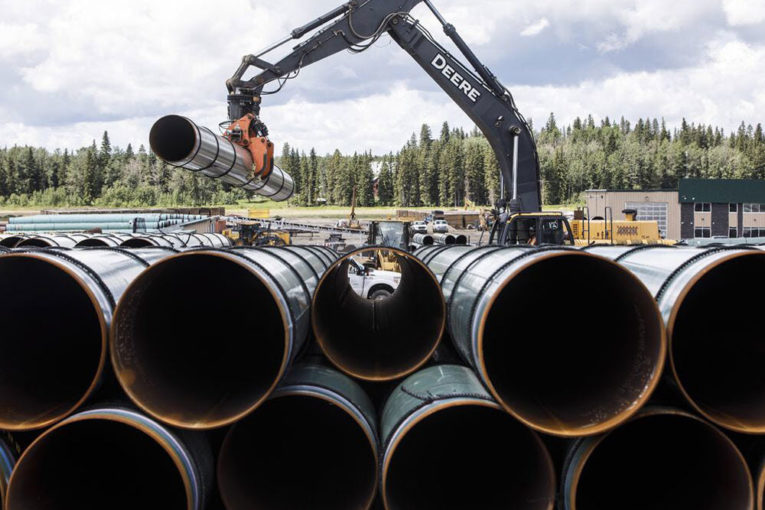
Grim. Gruesome. Gloomy: the short-term prospects for Canada’s oilpatch invite any number of depressing adjectives. Following an October election that effectively shut Alberta and Saskatchewan out of representation in Justin Trudeau’s new minority government (even though Alberta and Saskatchewan’s preferred party won a plurality of votes countrywide), November hasn’t done the West any favours.
At the start of the month, there was the symbolically rattling announcement that Encana was moving headquarters out of Calgary to the States — and losing the Canadian element of its name by taking on the thoroughly nondenominational (and odd) moniker Ovintiv.
That roughly coincided with an oil spill along the Keystone pipeline (operated by TC Energy, formerly known as TransCanada Pipelines – another oof! there) in North Dakota. The loss of pipeline capacity saw the price differential between Western Canadian Select and West Texas intermediate crude rise more than five dollars. Keystone came back online on Nov. 10, but the political fallout probably hasn’t ended, as U.S. congressional Democrats have demanded a federal review.
And then this week, a strike by CN workers came at pretty much the worst time, as it effectively halted the carrier’s shipments of crude-by-rail. The discount for WCS over WTI widened once again. Should the strike continue for any extended length of time, the glut of western oil could quickly go from concerning to critical.
Of course — or at least hopefully — these recent woes for the Canadian oil industry shall pass. (I know, I know — there are always new ones, it seems.) But if the air clears at some point, it’s probably not too soon to ask whether there remains any hope for a resurgence.
There are a lot of “ifs” here. Tapping the full potential of the oilpatch will require real progress on the government-owned Trans Mountain Pipeline — shovels might be in the ground, but there’s no end in sight to the legal hurdles the project faces. It will also require governments (plural) to address a tax and regulatory regime that compares unfavourably with the U.S. for oil companies. The federal Liberals’ lack of representation from Alberta and Saskatchewan, along with its effective reliance on the New Democrats to make policy, will provide high obstacles. And the Liberals’ official commitment to combating climate change won’t make kick-starting things any easier politically.
All of this is playing out against a radical shift in global petro-economics. In its most recent outlook report earlier this month, the Organization of Petroleum Exporting Countries (OPEC) once again lowered its global demand-growth forecasts, largely owing to slowing economic momentum amid worries over trade wars. The short-term price of crude is also fluctuating with concern over trade, falling as it’s become clearer the U.S.-China “Phase One” truce may not do much if anything to remove tariffs. Even rising tensions in the Mideast (with Iran at the epicentre) and a lower-than-expected increase in U.S. inventories this week haven’t done much to revive WTI.
So where is the hope?
Maybe you don’t have to look too hard to find it. For one thing, OPEC expects increased supply from Canada going forward. One reason is the perhaps-imminent start-up of Enbridge’s Line 3, a rebuild of an older pipeline that’s already competed in Canada, and is awaiting regulatory approval in the States. (It recently cleared an important hurdle in Minnesota.) When Line 3 comes online, it could increase Canadian crude exports by as much as 10 per cent, according to estimates. That might not do enough to solve the Canadian industry’s transport constraints, but it’s a start.
On a broader scale, it’s worth noting that growth in oil demand isn’t going away, even though it might slow. China is still a global driver of demand, and for the first nine months of this year crude imports rose by almost 10 per cent over the same period last year. India — another huge importer — has been suffering through economic doldrums this year, but the potential is clearly there for it to regain its position as a prime mover of demand growth. (India accounted for almost 20 per cent of it from 2013 to 2018.)
If China and India resume even more modest growth trajectories, they should continue to provide a floor for global prices. On the supply side, however, the evolving dynamic of global oil might be establishing a ceiling. Consider that even with production cuts from OPEC+ (OPEC and non-OPEC partners like Russia), prices still don’t really have liftoff. The North American industry has proven itself remarkably capable of filling in production gaps — and effectively capping prices. As U.S. shale production in particular shows few signs of slowing, that’s a trend that looks bound to continue reorienting the dynamics of pricing power.
But is that all a bad thing for the Canadian industry? Certainly, everyone wants to make more money, but there is also value in relative price stability, if that is indeed what the world is approaching. Stability makes planning long-timeline, big-capital-expenditure investments easier and less risky. For the oil patch, that means the booms — if they come at all — might not end up being so boomy, but maybe the busts will be less painful.
All Canada has to do is get out of its own way.
You can read more of the news on source
